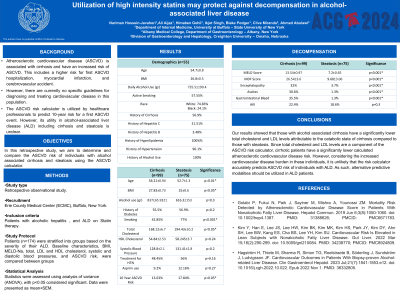Monday Poster Session
Category: Liver
P2880 - ASCVD Score Is Lower in Alcohol-Associated Cirrhosis Compared to Alcohol-Associated Steatosis
Monday, October 28, 2024
10:30 AM - 4:00 PM ET
Location: Exhibit Hall E

Has Audio
- NH
Nariman Hossein-Javaheri, DO
University at Buffalo
Buffalo, NY
Presenting Author(s)
Nariman Hossein-Javaheri, DO1, Ali A. Aijaz, DO1, Himaben Gohil, DO1, Ikjot Singh, MD1, Blake Podger, DO1, Clive J. Miranda, DO, MSc2, Ahmad Abulawi, MD3
1University at Buffalo, Buffalo, NY; 2CHI Health Creighton University Medical Center, Omaha, NE; 3Albany Medical Center, Albany, NY
Introduction: Atherosclerotic cardiovascular disease (ASCVD) is associated with cirrhosis and has an increased risk of ASCVD. This includes a higher risk for first ASCVD hospitalization, myocardial infarction, and cerebrovascular accident. However, there are currently no specific guidelines for diagnosing and treating cardiovascular disease in this population. The ASCVD risk calculator is utilized by healthcare professionals to predict 10-year risk for a first ASCVD event. However, its utility in alcohol-associated liver disease (ALD) including cirrhosis and steatosis is unclear. In this retrospective study, we aim to determine and compare the ASCVD risk of individuals with alcohol-associated cirrhosis and steatosis using the ASCVD calculator.
Methods: A174 patients with ALD were stratified based on the severity of their ALD. Baseline characteristics, BMI, MELD-Na, total, LDL and HDL cholesterol, systolic and diastolic blood pressures, and ASCVD risk, were compared between groups. Statistics were assessed using analysis of variance (ANOVA), with p< 0.05 considered significant. Data were presented as mean±SEM.
Results: 57% of the patients had cirrhosis with an average MELD of 13.5±0.9 and 43% had confirmed steatosis. Cirrhotic patients were older (56.2±09 vs 52.7±1.3 years of age; p< 0.05), had a greater BMI (27.8±0.7 vs 25±0.6kg/m2; p< 0.05), lower total cholesterol (168.2±6.6 vs 194.10mg/dl; p< 0.05), and LDL cholesterol (83.3±3.8 vs 101.3±6.7mg/dl; p< 0.05) but similar HDL (54.8±2.5 vs 58.18±3.7mg/dl; p=0.2). Although patients with cirrhosis had significantly lower diastolic blood pressure (78.5±1.4 vs 83.1±1.7mmHg; p< 0.05), their systolic pressures were similar to those with steatosis (128.8±2.0 vs 131.4±2.8mmHg; p=0.2). Finally, the ASCVD risk in cirrhotic patients was significantly lower (13.63±1.3 vs 17.8±1.8; p< 0.05).
Discussion: Our results showed that those with alcohol-associated cirrhosis have significantly lower total cholesterol and LDL levels attributable to the catabolic state of cirrhosis compared to those with steatosis. Since total cholesterol and LDL levels are a component of the ASCVD risk calculator, cirrhotic patients have a significantly lower calculated atherosclerotic cardiovascular disease risk. However, considering the increased cardiovascular disease burden in these individuals, it is unlikely that the risk calculator accurately predicts the ASCVD risk of individuals with ALD. As such, alternative predictive modalities should be utilized in ALD patients.
Disclosures:
Nariman Hossein-Javaheri, DO1, Ali A. Aijaz, DO1, Himaben Gohil, DO1, Ikjot Singh, MD1, Blake Podger, DO1, Clive J. Miranda, DO, MSc2, Ahmad Abulawi, MD3. P2880 - ASCVD Score Is Lower in Alcohol-Associated Cirrhosis Compared to Alcohol-Associated Steatosis, ACG 2024 Annual Scientific Meeting Abstracts. Philadelphia, PA: American College of Gastroenterology.
1University at Buffalo, Buffalo, NY; 2CHI Health Creighton University Medical Center, Omaha, NE; 3Albany Medical Center, Albany, NY
Introduction: Atherosclerotic cardiovascular disease (ASCVD) is associated with cirrhosis and has an increased risk of ASCVD. This includes a higher risk for first ASCVD hospitalization, myocardial infarction, and cerebrovascular accident. However, there are currently no specific guidelines for diagnosing and treating cardiovascular disease in this population. The ASCVD risk calculator is utilized by healthcare professionals to predict 10-year risk for a first ASCVD event. However, its utility in alcohol-associated liver disease (ALD) including cirrhosis and steatosis is unclear. In this retrospective study, we aim to determine and compare the ASCVD risk of individuals with alcohol-associated cirrhosis and steatosis using the ASCVD calculator.
Methods: A174 patients with ALD were stratified based on the severity of their ALD. Baseline characteristics, BMI, MELD-Na, total, LDL and HDL cholesterol, systolic and diastolic blood pressures, and ASCVD risk, were compared between groups. Statistics were assessed using analysis of variance (ANOVA), with p< 0.05 considered significant. Data were presented as mean±SEM.
Results: 57% of the patients had cirrhosis with an average MELD of 13.5±0.9 and 43% had confirmed steatosis. Cirrhotic patients were older (56.2±09 vs 52.7±1.3 years of age; p< 0.05), had a greater BMI (27.8±0.7 vs 25±0.6kg/m2; p< 0.05), lower total cholesterol (168.2±6.6 vs 194.10mg/dl; p< 0.05), and LDL cholesterol (83.3±3.8 vs 101.3±6.7mg/dl; p< 0.05) but similar HDL (54.8±2.5 vs 58.18±3.7mg/dl; p=0.2). Although patients with cirrhosis had significantly lower diastolic blood pressure (78.5±1.4 vs 83.1±1.7mmHg; p< 0.05), their systolic pressures were similar to those with steatosis (128.8±2.0 vs 131.4±2.8mmHg; p=0.2). Finally, the ASCVD risk in cirrhotic patients was significantly lower (13.63±1.3 vs 17.8±1.8; p< 0.05).
Discussion: Our results showed that those with alcohol-associated cirrhosis have significantly lower total cholesterol and LDL levels attributable to the catabolic state of cirrhosis compared to those with steatosis. Since total cholesterol and LDL levels are a component of the ASCVD risk calculator, cirrhotic patients have a significantly lower calculated atherosclerotic cardiovascular disease risk. However, considering the increased cardiovascular disease burden in these individuals, it is unlikely that the risk calculator accurately predicts the ASCVD risk of individuals with ALD. As such, alternative predictive modalities should be utilized in ALD patients.
Disclosures:
Nariman Hossein-Javaheri indicated no relevant financial relationships.
Ali Aijaz indicated no relevant financial relationships.
Himaben Gohil indicated no relevant financial relationships.
Ikjot Singh indicated no relevant financial relationships.
Blake Podger indicated no relevant financial relationships.
Clive Miranda indicated no relevant financial relationships.
Ahmad Abulawi indicated no relevant financial relationships.
Nariman Hossein-Javaheri, DO1, Ali A. Aijaz, DO1, Himaben Gohil, DO1, Ikjot Singh, MD1, Blake Podger, DO1, Clive J. Miranda, DO, MSc2, Ahmad Abulawi, MD3. P2880 - ASCVD Score Is Lower in Alcohol-Associated Cirrhosis Compared to Alcohol-Associated Steatosis, ACG 2024 Annual Scientific Meeting Abstracts. Philadelphia, PA: American College of Gastroenterology.
